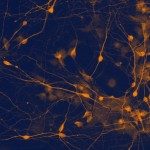Link to Pubmed [PMID] – 21307257
Link to DOI – 10.1523/JNEUROSCI.5514-10.2011
J Neurosci 2011 Feb; 31(6): 2205-15
The fragile X mental retardation protein (FMRP) is an RNA-binding protein essential for multiple aspects of neuronal mRNA metabolism. Its absence leads to the fragile X syndrome, the most prevalent genetic form of mental retardation. The anatomical landmark of the disease, also present in the Fmr1 knock-out (KO) mice, is the hyperabundance of immature-looking lengthened dendritic spines. We used the well known continuous production of adult-born granule cells (GCs) in the mouse olfactory bulb (OB) to analyze the consequences of Fmrp loss on the differentiation of GCs. Morphological analysis of GCs in the Fmr1 KO mice showed an increase in spine density without a change in spine length. We developed an RNA interference strategy to cell-autonomously mutate Fmr1 in a wild-type OB network. Mutated GCs displayed an increase in spine density and spine length. Detailed analysis of the spines through immunohistochemistry, electron microscopy, and electrophysiology surprisingly showed that, despite these abnormalities, spines receive normal glutamatergic synapses, and thus that mutated adult-born neurons are synaptically integrated into the OB circuitry. Time-course analysis of the spine defects showed that Fmrp cell-autonomously downregulates the level and rate of spine production and limits their overgrowth. Finally, we report that Fmrp does not regulate dendritogenesis in standard conditions but is necessary for activity-dependent dendritic remodeling. Overall, our study of Fmrp in the context of adult neurogenesis has enabled us to carry out a precise dissection of the role of Fmrp in neuronal differentiation and underscores its pleiotropic involvement in both spinogenesis and dendritogenesis.

